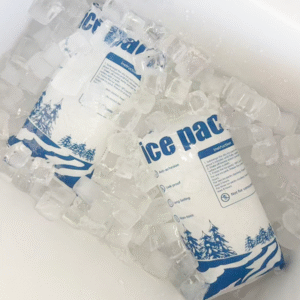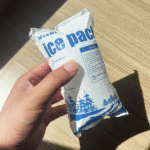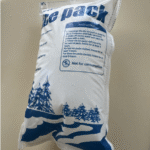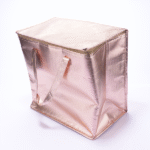72 Pacote de gelo seco por hora: Como manter mercadorias congeladas por 72 Horas
Introdução: Quando você precisa enviar alimentos congelados, vacinas ou amostras de laboratório em todo o país, manter temperaturas abaixo de zero por três dias não é uma tarefa fácil. Uma bolsa de gelo seco de 72 horas pode manter os produtos congelados por até 72 horas quando combinado com o isolamento e manuseio corretos. Entendendo como funciona o gelo seco, quanto é necessário e como cumprir as regras de segurança é essencial. Este artigo explica tudo o que você precisa saber sobre como usar um 72 bloco de gelo seco por hora—de cálculos simples a soluções de ponta 2025 inovações - para que seus produtos cheguem congelados e seguros.

O que é uma bolsa de gelo seco de 72 horas e como funciona? - explorar dióxido de carbono sólido e propriedades de sublimação.
Como você calcula a quantidade de gelo seco para remessa de 72 horas? — aprenda regras práticas simples com base no peso da carga útil e no tempo de trânsito.
Qual embalagem isolada funciona melhor para bolsas de gelo seco de 72 horas? — compare materiais e designs para remessas de longa duração.
Quais regras regulatórias e de segurança se aplicam às bolsas de gelo seco de 72 horas em 2025? - entenda a rotulagem, limites de materiais perigosos e dicas de manuseio.
Quais são as últimas 2025 tendências e inovações para transporte de gelo seco de longa duração? — descubra sensores inteligentes, refrigeração híbrida e crescimento do mercado.
O que é uma bolsa de gelo seco de 72 horas e como funciona?
Resposta direta: UM 72bloco de gelo seco por hora é um método de envio que utiliza gelo seco para manter os produtos congelados por aproximadamente três dias. Gelo seco é sólido dióxido de carbono (Co₂) que sublima - passa diretamente de sólido para gasoso - a -78,5 °C. Porque não derrete na água, o gelo seco fornece frio sem umidade e pode manter os produtos abaixo de zero por 24 a 72 horas, dependendo da quantidade e do isolamento. Isso o torna ideal para o envio de alimentos congelados, amostras biológicas ou farmacêuticas em longas distâncias.
Explicação detalhada: Quando o gelo seco sublima, absorve grandes quantidades de calor, mantendo o ambiente circundante frio. A taxa de sublimação depende da temperatura ambiente, isolamento do recipiente e o tamanho dos pedaços de gelo seco. Menor, peças uniformes sublimam mais lentamente porque têm menos área de superfície exposta. Em um 72bloco de gelo seco por hora, o gelo seco é normalmente colocado no topo da carga dentro de um contêiner isolado; Air frio afunda, portanto, posicionar o gelo seco acima das mercadorias garante um congelamento uniforme. Para durações mais longas, gelo seco pode ser colocado acima e abaixo do produto. Ao contrário dos pacotes de gel, que mantêm temperaturas acima 0 °C, gelo seco pode manter o conteúdo abaixo de zero por dias. No entanto, deve ser manuseado com cuidado – recipientes não ventilados podem explodir, e o contato direto com gelo seco pode causar queimaduras.
Química e sublimação do gelo seco
O gelo seco sublima porque as moléculas de CO₂ passam diretamente do sólido para o gasoso a baixa pressão. Ao nível do mar, esta transição ocorre a −78,5 °C. A sublimação absorve o calor do ambiente (calor latente de sublimação ~571 kJ/kg), que retira energia térmica da sua remessa. A ausência de água líquida significa que não há água derretida suja que possa danificar embalagens ou produtos. Pedaços de gelo seco para envio estão disponíveis em blocos, fatias ou pellets. Os blocos duram mais, mas são mais difíceis de embalar em torno de produtos com formatos irregulares; pellets fornecem melhor distribuição, mas sublimam mais rápido. Um típico 72bloco de gelo seco por hora usa 1.5 vezes o peso do produto em gelo seco e isolamento de alto desempenho.
| Estado de gelo seco | Ponto de sublimação | Intervalo de tempo de resfriamento | Benefício prático para você |
| Bloco ou Fatia | −78,5°C (−109,3 °F) | 48–72 horas com bom isolamento | Dura mais; ideal para grandes cargas que necessitam de congelamento sustentado. |
| Pellets | −78,5°C | 24–48 horas | Fornece distribuição uniforme do frio, mas sublima mais rapidamente devido à maior área de superfície. |
| Batatas fritas/trituradas | −78,5°C | <24 horas | Preenche vazios facilmente; útil para remessas curtas ou para preencher lacunas, mas não é adequado para 72 horas. |
Dicas e sugestões práticas
Escolha a forma adequada de gelo seco: Por um 72bloco de gelo seco por hora, opte por blocos ou fatias grandes em vez de pellets, pois sublimam mais lentamente e mantêm o frio por mais tempo.
Posicione o gelo seco corretamente: Coloque a maior parte do gelo seco em cima da carga, pois o ar frio desce. Para remessas pesadas (>30 Libra), coloque um pouco de gelo seco no fundo também.
Não sele aeronave: Sempre ventile o recipiente; Co₂ o gás deve escapar. Use recipientes isolados com recursos de ventilação ou deixe pequenos espaços na tampa.
Exemplo de caso: Uma empresa de biotecnologia enviou amostras de vacinas para todo o país embalando frascos em uma caixa isolada de poliuretano com 1.5 vezes o peso do produto em gelo seco. Eles usaram embalagens ventiladas e seguiram a Associação Internacional de Transporte Aéreo (IATA) regras de rotulagem. A remessa manteve temperaturas abaixo de -20 °C durante 72 horas e chegou intacto.
Como você calcula o gelo seco para uma remessa de 72 horas?
Resposta direta: Você calcula gelo seco para um 72bloco de gelo seco por hora multiplicando o peso da carga útil por 1.5. As diretrizes da indústria recomendam o uso de metade do peso de gelo seco do produto para remessas noturnas (24 horas), peso igual para 48 horas, e 1.5 vezes o peso para 72 horas. Por exemplo, um 10 carga útil lb requer 15 lb de gelo seco para permanecer congelado por até 72 horas.
Explicação detalhada: O gelo seco sublima a uma taxa de 5 a 10 libras por 10 a 15 libras de mercadorias por 24 horas. Temperatura ambiente, a qualidade do isolamento e a temperatura inicial influenciam esta taxa. A tabela abaixo fornece uma regra prática para diferentes cargas e durações, :
| Carga útil | Gelo seco para <12 h | Gelo seco por 24–48 horas | Gelo seco por 48–72 horas | Significado prático |
| 5 Libra | 3 Libra | 5 Libra | 10 Libra | Pacotes pequenos precisam de mais gelo para viagens mais longas; dobrar o peso prolonga o tempo congelado. |
| 10 Libra | 5 Libra | 10 Libra | 15 Libra | O peso igual mantém os itens congelados por dois dias; adicionando 5 lb garante 72 horas. |
| 20 Libra | 10 Libra | 20 Libra | 30 Libra | Cargas maiores requerem gelo seco proporcional; 1.5× peso para 72 horas. |
| 40 Libra | 15 Libra (principal), 5 Libra (fundo) | 25 Libra (principal), 15 Libra (fundo) | 40 Libra (principal), 20 Libra (fundo) | Posicionar mais gelo no topo melhora o desempenho; camada inferior ajuda para cargas pesadas. |
Dicas para cálculos precisos
Teste seu pacote: As condições variam. Realize uma remessa de teste com registradores de dados de temperatura para verificar se o peso 1,5× mantém as temperaturas durante todo o período. 72 horas.
Considere os atrasos: A UPS recomenda adicionar gelo seco suficiente para um extra 24 horas para cobrir possíveis atrasos no trânsito.
Tamanho é importante: Use menor, pedaços uniformes de gelo seco para retardar a sublimação e obter distribuição consistente.
Exemplo: Enviando um 20 Uma caixa de 1 kg de peixe congelado requer cerca de 30 lb de gelo seco para uma viagem de 72 horas. Lugar 20 lb em cima e 10 lb na parte inferior para resfriamento ideal.
Qual embalagem isolada funciona melhor para uma bolsa de gelo seco de 72 horas?
Resposta direta: O melhor isolamento para um 72bloco de gelo seco por hora é uma caixa de alto desempenho feita de poliestireno expandido (EPS), espuma de poliuretano ou painéis isolados a vácuo. O isolamento retarda a transferência de calor do ambiente, Permitir que o gelo seco dure mais tempo. Espuma espessa ou painéis de vácuo são recomendados para remessas com mais de 48 horas.
Explicação detalhada: Caixas isoladas vêm em vários materiais, cada um oferecendo resistência térmica diferente (Valor R) e durabilidade. Aqui estão as opções comuns:
| Material | Desempenho térmico (Valor R) | Aplicações Típicas | Significado para você |
| Resfriadores de espuma EPS | Moderado (≈3,6 por pol.) | Remessas de alimentos, produtos farmacêuticos | Acessível e amplamente disponível; adequado para remessas de até 48 h. |
| Espuma de poliuretano | Alto (≈6–7 por polegada) | Produtos farmacêuticos de alto valor, Amostras de biotecnologia | Oferece melhor isolamento para remessas de 72 horas, mas custa mais. |
| Papelão ondulado + forros de folha | Variável | Kits de refeições, mantimentos | Leve e reciclável; use para remessas curtas ou quando o peso for importante. |
| Painéis isolados a vácuo (VIPs) | Muito alto (25–30 por polegada) | Remessas especiais (vacinas, Biologics) | Extremamente eficiente; estende o desempenho do bloco de gelo seco em 72 horas, mas é caro. |
Dicas e sugestões práticas
Escolha a espessura: O isolamento mais espesso prolonga o tempo de trânsito. Para remessas acima 48 horas, use painéis de espuma de várias peças ou caixas isoladas a vácuo.
Deixe espaço para gelo seco: A caixa deve fornecer espaço para gelo seco acima das mercadorias e amortecimento nas laterais.
Use forros reflexivos: Materiais reflexivos reduzem o ganho de calor radiante e podem melhorar o desempenho, especialmente em climas quentes.
Dica do mundo real: Para uma bolsa de gelo seco de 72 horas, uma caixa de poliuretano de 1,5 polegadas de espessura com painel isolado a vácuo pode reduzir o consumo de gelo em até 20 %, mas custa mais. Se o custo é uma preocupação, uma caixa de espuma EPS com forro de alumínio fornece um bom equilíbrio por períodos de 72 horas.
Quais regras regulatórias e de segurança se aplicam às bolsas de gelo seco de 72 horas em 2025?
Resposta direta: Lidando com um 72bloco de gelo seco por hora exige conformidade com regulamentos de materiais perigosos e equipamentos de segurança adequados. NÓS. regulamentos (49 Cfr) e as regras da IATA classificam o gelo seco como uma Classe 9 materiais perigosos. Os pacotes devem exibir a ONU 1845 rótulo, declarar o peso líquido do gelo seco e usar recipientes ventilados. As remessas internacionais em aeronaves de passageiros estão limitadas a 2.5 kg (5.5 Libra) de gelo seco por pacote, enquanto os voos de carga permitem até 200 kg. Os expedidores devem usar luvas de proteção, óculos de proteção e babadores para evitar queimaduras.
Explicação detalhada: A segurança do gelo seco abrange diversas áreas:
Rotulagem e marcação: Os pacotes devem levar a designação “UN 1845” e uma Classe 9 Etiqueta de perigo. O peso líquido do gelo seco deve ser marcado. Isso garante a conformidade e alerta os manipuladores sobre perigos potenciais.
Ventilação: Os contêineres devem permitir que o gás CO₂ escape. Recipientes herméticos correm o risco de acúmulo de pressão e ruptura.
Limites de peso: Remessas não médicas contendo mais de 5.5 Libra (2.5 kg) de gelo seco nos EUA. deve cumprir 49 Regras CFR. A IATA restringe o gelo seco a 2.5 kg por pacote em voos de passageiros e até 200 kg em voos de carga. A UPS sugere adicionar gelo seco extra para atrasos no trânsito e fornece recipientes de espuma EPS de alta densidade para reduzir a sublimação.
Equipamento de manuseio: Use óculos de proteção, luvas isoladas e roupas de proteção ao manusear gelo seco. Evite o contato direto com a pele para evitar queimaduras. Use pinças ou colheres para transferir gelo seco.
Armazenar: Armazene gelo seco em uma área bem ventilada usando recipientes não herméticos. Nunca armazene gelo seco em um refrigerador completamente vedado ou porão sem ventilação.
Disposição: Deixe que os restos de gelo seco sublimem em um local seguro, espaço ventilado. Nunca jogue-o na pia ou coloque-o em uma lixeira fechada.
Exemplo prático: Ao enviar uma bolsa de gelo seco de 72 horas por via aérea, você precisará pesar o gelo seco e incluir esse número na declaração de materiais perigosos. Por um 15 carga útil de lb exigindo 22.5 lb de gelo seco, apenas 5.5 lb pode ser incluído em um único pacote em um voo de passageiros; o restante precisaria ser distribuído ou enviado em aviões de carga.
Dicas adicionais para um manuseio seguro
Combine gelo seco com pacotes de gel ou PCMs para estabilidade: Pacotes híbridos podem reduzir o uso de gelo seco enquanto mantêm a temperatura.
Treine a equipe: Qualquer pessoa envolvida na embalagem ou manuseio deve ser treinada nas regulamentações de materiais perigosos. Forneça instruções claras para abrir pacotes com segurança.
Use sensores de CO₂: Sensores inteligentes podem detectar o acúmulo de CO₂ e alertar os manipuladores para ventilar o pacote, se necessário.
Como combinar gelo seco com pacotes de gel ou PCMs para envio em 72 horas?
Resposta direta: Combinação de gelo seco com pacotes de gel ou materiais de mudança de fase (PCMs) pode prolongar a duração de um 72bloco de gelo seco por hora e reduzir as emissões de CO₂. Os pacotes de gel mantêm temperaturas próximas de 2–8 °C e são ideais para produtos refrigerados, enquanto os PCMs mantêm faixas de temperatura específicas (por exemplo, 0 °C, 5 °C, −20°C). Combinando gelo seco com PCMs, você cria um pacote híbrido que fornece temperaturas estáveis e reduz a quantidade de gelo seco necessária.
Explicação detalhada: O resfriamento híbrido funciona usando gelo seco para atingir temperaturas ultrabaixas e PCMs para amortecer as flutuações de temperatura. PCMs são substâncias que absorvem ou liberam calor à medida que mudam de fase, mantendo uma temperatura constante. Por exemplo, um PCM com ponto de fusão de -20 °C pode manter os produtos nessa temperatura quando o gelo seco começa a sublimar. O uso de PCMs também reduz o peso e a classificação de perigo das remessas porque é necessário menos gelo seco.
Dicas para pacotes híbridos
Selecione a temperatura PCM correta: Escolha um PCM que corresponda à faixa de temperatura exigida pelo seu produto (por exemplo, 0 °C para produtos refrigerados ou −20 °C para produtos congelados). Isso garante um buffer eficaz.
Use pacotes de gel para a última milha: Pacotes de gel podem ser adicionados nas últimas 12 a 24 horas de trânsito para manter a temperatura depois que o gelo seco se dissipar.
Equilibre peso e custo: PCMs e pacotes de gel adicionam peso; calcule o custo combinado e o peso de envio para garantir que seja econômico.
Exemplo: Um mensageiro médico que envia vacinas usa 10 lb de gelo seco e um painel PCM de −20 °C. O PCM absorve calor e limita picos de temperatura, permitindo que a remessa mantenha -20 °C por 72 horas com apenas 10 lb de gelo seco em vez de 15 Libra. Isso reduz a papelada de materiais perigosos e as emissões de carbono.
2025 tendências e inovações para bolsas de gelo seco de 72 horas
Visão geral da tendência
A indústria da cadeia fria está evoluindo rapidamente. Em 2025, sensores inteligentes, a produção sustentável de gelo seco e as embalagens híbridas estão transformando a forma como 72pacotes de gelo seco por hora são projetados e usados. As remessas são mais inteligentes, mais verde e mais eficiente do que nunca.
Últimos desenvolvimentos de vista
Produção sustentável de gelo seco: Os fornecedores estão adotando uma fabricação mais ecológica, capturando CO₂ de processos industriais como a síntese de amônia. Fontes de energia renováveis também estão sendo usadas para produzir gelo seco, reduzindo sua pegada de carbono.
Embalagem híbrida e PCMs: A combinação de gelo seco com PCMs ou pacotes de gel reduz o uso de CO₂ e o peso do envio. Esta abordagem suporta durações mais longas sem aumentar a classificação de perigo.
Embalagem e rastreamento inteligentes: A nova embalagem apresenta sensores inteligentes de CO₂ e etiquetas com código QR que fornecem dados de temperatura e localização em tempo real. Alguns sistemas se integram ao blockchain, registrando cada etapa da cadeia de frio para rastreabilidade.
Automação e IA em logística: Sistemas automatizados lidam com embalagens de gelo seco para reduzir erros humanos. Ferramentas baseadas em IA prevêem impactos climáticos e otimizam quantidades de gelo seco, ajudando a reduzir o desperdício.
Crescimento do mercado: Os EUA. mercado de embalagens da cadeia de frio foi avaliado em dólares 7.97 bilhão em 2024 e deverá crescer a uma taxa composta de crescimento anual (Cagr) de 15.6 % entre 2025 e 2030. Demanda por alimentos processados, compras on-line de supermercado e padrões farmacêuticos rígidos impulsionam esse crescimento. Pacotes frios (pacotes de gel, PCMs) deverão crescer a um CAGR de 17.6 %.
Insights de mercado
Consumidores e reguladores estão pressionando por soluções mais ecológicas, soluções de cadeia de frio mais confiáveis. A mudança para a produção ecológica de gelo seco e materiais de isolamento recicláveis reflete preocupações crescentes de sustentabilidade. Enquanto isso, o aumento dos kits de refeição e dos alimentos congelados diretos ao consumidor significa que mais empresas precisam de opções acessíveis de bolsas de gelo seco para 72 horas. Investir em sensores inteligentes e embalagens híbridas pode reduzir devoluções e desperdícios, melhorando a lucratividade.
Perguntas frequentes
Pergunta 1: Quanto gelo seco eu preciso para uma remessa de 72 horas?
Usar 1.5 vezes o peso do seu produto. Por exemplo, um 10 lb carga útil requer cerca de 15 lb de gelo seco. Adicione gelo seco extra para atrasos.
Pergunta 2: Posso combinar gelo seco com pacotes de gel?
Sim. A combinação de gelo seco com pacotes de gel ou PCMs retarda a sublimação e prolonga o resfriamento. As embalagens híbridas são especialmente úteis quando os produtos não devem ser expostos a temperaturas extremamente baixas.
Pergunta 3: É seguro enviar gelo seco internacionalmente?
O gelo seco pode ser enviado internacionalmente, mas deve cumprir as regras da IATA. Aeronaves de passageiros permitem apenas 2.5 kg (5.5 Libra) por pacote, enquanto os voos de carga permitem até 200 kg.
Pergunta 4: Que isolamento devo usar para remessa de 72 horas?
Use isolamento de alto desempenho, como espuma de poliuretano ou painéis isolados a vácuo, para remessas 48 horas.
Pergunta 5: Como faço para descartar restos de gelo seco?
Deixe o gelo seco sublimar em uma área bem ventilada. Não coloque-o em uma pia ou recipiente lacrado.
Pergunta 6: Que equipamento de segurança eu preciso?
Use luvas isoladas, óculos de proteção e roupas de proteção ao manusear gelo seco. Evite o contato com a pele e mantenha o gelo seco longe do alcance de crianças e animais de estimação.
Pergunta 7: O gelo seco deixa umidade?
Não. O gelo seco sublima diretamente em gás dióxido de carbono, não deixando água líquida. Isso evita danos à embalagem e facilita a limpeza.
Pergunta 8: Quanto tempo dura o gelo seco?
O gelo seco pode manter o frio por 24 a 72 horas, dependendo da quantidade e do isolamento. Para remessas de 72 horas, usar 1.5 vezes o peso do produto em gelo seco.
Pergunta 9: Posso reutilizar pacotes de gelo seco?
Não. O gelo seco sublima e não pode ser reutilizado. No entanto, recipientes isolados e painéis PCM muitas vezes podem ser reutilizados com gelo seco novo.
Pergunta 10: Qual é a diferença entre gelo seco e pacotes de gel?
O gelo seco mantém os produtos abaixo de zero por dias, enquanto os pacotes de gel mantêm temperaturas geladas acima 0 °C. As embalagens de gel não são classificadas como perigosas e são mais fáceis de manusear, mas não podem manter os produtos congelados.
Resumo e recomendações
O 72bloco de gelo seco por hora é uma maneira eficaz de transportar produtos congelados por longas distâncias. Lembre-se destes pontos-chave:
Entenda o gelo seco: O CO₂ sólido sublima a -78,5 °C e mantém os produtos congelados sem umidade.
Calcule corretamente: Usar 1.5 vezes o peso do produto em gelo seco para 72 horas. Realize remessas de teste e adicione gelo seco extra para evitar atrasos.
Escolha o isolamento certo: Caixas de alto desempenho feitas de EPS, espuma de poliuretano ou painéis isolados a vácuo prolongam a vida útil da sua bolsa de gelo seco de 72 horas.
Siga as regras de segurança: Rotular pacotes com a ONU 1845, ventile os recipientes e use equipamento de proteção, .
Abrace a inovação: Pacotes híbridos, sensores inteligentes e produção sustentável de gelo seco reduzem custos e impacto ambiental, .
Orientação acionável
Para implementar um sucesso 72bloco de gelo seco por hora remessa:
Avalie as necessidades do seu produto: Determine se seus produtos devem permanecer congelados ou simplesmente resfriados.
Selecione isolamento: Escolha uma caixa isolada com material e espessura adequados para 72 horas. Painéis isolados em poliuretano ou a vácuo são ideais para viagens longas.
Calcular gelo seco: Use a regra 1,5× e adicione um buffer para atrasos. Coloque o gelo por cima e, para cargas pesadas, adicione um pouco na parte inferior.
Preparar embalagem: Pré-condicione a caixa e gelo seco. Embrulhe os produtos em sacos à prova de vazamentos e use amortecimento. Garanta ventilação.
Etiquetar e enviar: Marque o pacote com a ONU 1845, declarar o peso do gelo seco e seguir os limites IATA/49 CFR.
Monitore em trânsito: Use sensores de temperatura e registradores de dados para rastrear a remessa. Para viagens cross country, use transportadoras com tempos de trânsito confiáveis e otimização de rotas.
Sobre Tempk
A Tempk é um fornecedor confiável de soluções de embalagem para cadeia de frio, oferecendo caixas isoladas, bolsas de gelo em gel e 72bloco de gelo seco por hora sistemas para alimentos, indústrias farmacêuticas e de biotecnologia. Operamos um laboratório certificado CNAS e R&Centro D para garantir qualidade e inovação do produto. Nossos produtos ecológicos da cadeia de frio são reutilizáveis e recicláveis, e nossas soluções de embalagem são certificadas por padrões internacionais e conformidade com Sedex. Somos especializados em produtos de isolamento personalizados, de embalagens de gel a caixas isoladas a vácuo, adaptado para atender aos requisitos de temperatura e duração de suas remessas. Com tempk, você se beneficia de conhecimento científico e entrega confiável – um parceiro comprometido em manter suas mercadorias seguras durante o transporte.
Chamado à ação
Pronto para enviar com confiança? Contate a equipe Tempk hoje para uma consulta gratuita e personalizada 72bloco de gelo seco por hora solução. Ajudaremos você a escolher o isolamento certo, calcule gelo seco e implemente tecnologia de ponta para proteger seus produtos. Esteja você enviando alimentos congelados, produtos farmacêuticos ou amostras de pesquisa, A Tempk possui as ferramentas e a experiência para garantir segurança, entrega sustentável.























